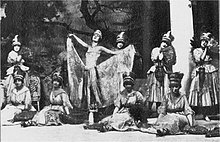Ida Adams | |
|---|---|
 Ida Adams and chorus in
Houp La! | |
| Born | Ida M. Adams c. 1888 |
| Died | November 4, 1960 (aged 71–72) |
| Occupation(s) | Stage actress, singer |
Ida Adams (c. 1888 – November 4, 1960), sometimes credited as Ida M. Adams, [1] was an American-born actress and singer who worked chiefly in musical theatre.
Her career from 1909 to 1914 was in the United States, then in London's West End from 1915 to 1917.
Life
Adams's third appearance on stage was at the Knickerbocker Theatre on Broadway on April 27, 1909, playing Miss Glick in The Candy Shop. Later that year, she toured in Three Twins, as Summer Girl and Boo Hoo Tee Hee Girl. In 1911 she was Desirée in the musical The Pink Lady at the New Amsterdam Theatre, after which she went on tour with the show. She was next in Florenz Ziegfeld's A Winsome Widow (1912), at the Moulin Rouge, in New York, playing the role of Tony. From October 1912 she appeared in the Ziegfeld Follies of 1912, which ran until January 1913. [2] [3]
After Ziegfeld Follies, Adams moved to London, playing at the London Hippodrome in 1915, appearing the next year in the revue Half-Past Eight at the Comedy Theatre, and then in Charles B. Cochran's Houp La! (1916) at St Martin's Theatre. She recorded two songs from Houp La! for the His Master's Voice label at the Gramophone Company's studios at Hayes, Middlesex, on 11 January 1917. The first of these was "Oh! How She Could Yacki Hacki Wicki Wacki Woo," accompanied by a female choir and the St Martin's Theatre Orchestra, [4] [5] while the second was Paul Rubens's "Wonderful Girl, Wonderful Boy, Wonderful Time", sung as a trio with Gertie Millar and Nat Ayer. [4]
Cochran later recalled that Binnie Hale had "got her first chance" in Houp-La! as Adams's understudy, but that she had a "harassing debut" because Adams, having insisted on paying for her own clothes, had also stipulated that no understudy should wear them. [6] In 1977, a member of the Houp La! cast from 1916 recalled in The Listener:
There was a wonderful American woman named Ida Adams in the cast. She was spectacular! They used to keep some staff on at the bank every night, so that she could put all her jewellery back after the show. Oh, she was glorious! [7]
Adams's last known theatrical appearance was as Jane Gerson in the play Inside the Lines (1917), which had a long run at the Apollo Theatre, London. [2] The Sketch said of Inside the Lines "The charm and beauty of Miss Ida Adams are very attractive features of a remarkable and topically interesting production, in which also appear Miss Grace Lane, Mr. Eille Norwood, Mr. Frederick Ross, Mr. E. Dagnall, and other well-players." [8]
Adams died on November 4, 1960, aged 72. [9]
A costume drawing, “Miss Ida Adams”, in the Museum of the City of New York, is attributed to Lucy, Lady Duff-Gordon, who worked on Ziegfeld Follies. [10]
Some sources conflate Ida M. Adams and Ida M. Evans, an American short story writer active in the same era. [11]
References
- ^ The New York Commercial Register for 1919–1920 listed her as "Adams Ida M. (Miss), 140 W. 55th. Actress."The Commercial Register (Retail Dealers' Protective Association, 1920), p. 5
- ^ a b 'Adams, Ida', in Who Was Who in the Theatre, 1912-1976: a biographical dictionary (vol. 1, Gale Research Co., Detroit, 1978), p. 9
- ^ Ruth Benjamin, Arthur Rosenblatt, Who Sang What on Broadway, 1866-1996: The Singers (A-K) (McFarland & Co., Publishers, 2006), p. 7
- ^ a b Kurt Gänzl, British Musical Theatre vol. 2 (Oxford University Press, 1986), p. 1153: 'Wonderful Girl, Wonderful Boy, Wonderful Time' (Gertie Millar, Ida Adams, Nat D. Ayer) HMV 04193 (1917)... 'Oh! How She Could Yacki Hacki Wicki Wacki Woo' (Ida Adams w. chorus) HMV 03542 (1917)"
- ^ The Sketch, vol. 96 (1916), p. 232: "Miss Ida Adams as Ada Eve, a Dancer, sings... "Wonderful Boy, Wonderful Time," and she also sings a song with the curious title of "Oh! How She Could Yacki Hacki Wicki Wacki Woo"
- ^ C. B. Cochran, The Secrets of a Showman (1925), p. 226
- ^ The Listener, vol. 97 (British Broadcasting Corporation, 1977), p. 268
- ^ 'From "Houp-La!" to "Inside the Lines"' in The Sketch, vol. 98 (1917), p. 181
- ^ Freda Gaye & John Parker, Who's Who in the Theatre: a biographical record (Pitman Publishing Corporation, 1967), p. 1583
- ^ Delbert Unruh, Ione C. Unruh, Forgotten Designers (Page Publishing Inc, 2018), p. 274
- ^ Vogel, Michelle (November 29, 2014). Olive Thomas: The Life and Death of a Silent Film Beauty. McFarland. p. 163. ISBN 978-0-7864-5526-3.